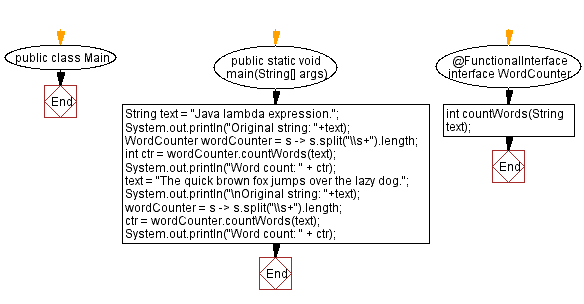Java Program to count words in a sentence using lambda expression
13. Count words in sentence with lambda
Write a Java program to implement a lambda expression to count words in a sentence.
Sample Solution:
Java Code:
public class Main {
public static void main(String[] args) {
String text = "Java lambda expression.";
System.out.println("Original string: " + text);
WordCounter wordCounter = s -> s.split("\\s+").length;
int ctr = wordCounter.countWords(text);
System.out.println("Word count: " + ctr);
text = "The quick brown fox jumps over the lazy dog.";
System.out.println("\nOriginal string: " + text);
wordCounter = s -> s.split("\\s+").length;
ctr = wordCounter.countWords(text);
System.out.println("Word count: " + ctr);
}
}
@FunctionalInterface
interface WordCounter {
int countWords(String text);
}
Sample Output:
Original string: Java lambda expression. Word count: 3 Original string: The quick brown fox jumps over the lazy dog. Word count: 9
Explanation:
In the above code the wordCounter variable is assigned a lambda expression that splits the input string by whitespace (\\s+) and counts the number of resulting substrings using the length method. The countWords method of the wordCounter instance is then called with the text string. The result is stored in the "ctr" variable. Finally, the word count is printed to the console.
Flowchart:

For more Practice: Solve these Related Problems:
- Write a Java program to implement a lambda expression that counts words in a sentence after removing punctuation.
- Write a Java program to create a lambda that splits a sentence into words and filters out stop words before counting.
- Write a Java program to implement a lambda that maps each word in a sentence to its length and then sums these lengths.
- Write a Java program to chain lambda expressions to count the words and then output the most frequently occurring word.
Go to:
PREV : Multiply and sum list elements using lambda.
NEXT : Check if string is palindrome using lambda.
Live Demo:
Java Code Editor:
Improve this sample solution and post your code through Disqus
What is the difficulty level of this exercise?
Test your Programming skills with w3resource's quiz.
